|
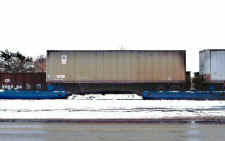
Farmingdale bogies
loaded 1988 Photo: John Volpi
The end cars (Number 8000 series,
“A” cars) featured a standard height tight lock (Type H) coupler and
a set of cast steel counterweights. The other end featured the fifth
wheel hitch.
 LIRR
#8001 A end car Photo: Al Castelli LIRR
#8001 A end car Photo: Al Castelli
Next in line would be the
intermediate car (Number 1000 Series, “C” cars). On one end would be
a set of wells for the trailers tires to sit in, and on the other end, a
fifth wheel hitch. Both ends of the car had low height couplers.
 LIRR
#1001 C type Photo: Al Castelli LIRR
#1001 C type Photo: Al Castelli
The next and final car (Number
9000 series, “B” cars) would have only a set of wells for the
wheels, then on the end would be steel counterweights and a standard
height Type H coupler.
 LIRR #9003 LI City 07/04/2005 LIRR #9003 LI City 07/04/2005
Photo: John McCluskey
Originally, the cars had black
lettering, but this would be changed to white lettering later on. An air
hose would be slung under the trailer and connected to the next car to
operate the trains air brakes.
A more refined red air hose reel
was also added, along with guides for the truck tires on the wells. An
interesting note is that these cars did not have a center sill like
almost every other freight car has. The cars feature heavy duty 12"
x 9" rectangular box cross supports. The sides of the car were
thick metal which acted as a side sill.
A typical consist would appear as
such: A-C-C-C-C-B. Loading and unloading would be handled by a pair of
custom built cranes, one located on the Wye Team Track in Pinelawn, Long
Island, New York; and the other in the Greenville Yard, in New Jersey.
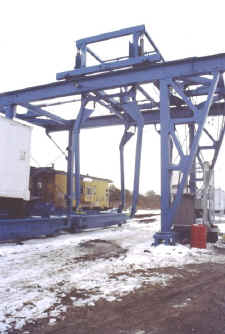 LIRR bogie
crane Farmingdale view S
Albert Castelli photo LIRR bogie
crane Farmingdale view S
Albert Castelli photo
These bogies were in limited
service when they were built, but it was soon discovered they were prone
to derailments due to their overall light weight even when loaded, and
due to the fact there were only two axles per car as opposed to four,
which made the Bogie not-as-forgiving, in regard to "less than
perfect trackage".
The trailer loader / unloaders
were also problem prone. Subsequently, the Federal Railway
Administration limited the Bogies to 20 miles per hour and no more than
15 cars per train.
Initial usage has seen these Bogie
sets used to transport United States Postal Service trailers to the USPS
Processing & Distribution Center located in Farmingdale.
The USPS, after a loaded trailer was destroyed due
to arson and declared a total loss in the Bush Terminal yard, was no
longer a customer.
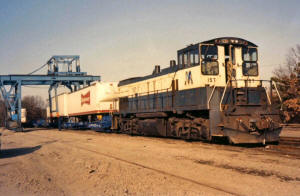
Last service was 12/1991 for Clare
Rose Beer. Of the cars built, some of them were NEVER used of the
2nd order, as service ended so soon. There were 2 un-loaders built, one
in Greenville, NJ. The other in Pinelawn/Farmingdale, NY which were
scrapped. Perhaps, Berwick built them also.
The cars came to Greenville on flatcars from Berwick and were unloaded
there.
The bogies were tested again in
the early 1990's, to transport trailers for Clare Rose beer
distributors. No discernible modifications were evident; and once again
in limited service only. As far as this author has been able to learn,
this test resulted in the bogies not having any appreciable advantage
over truck traffic, and the Bogies once again experienced technical
problems, along with rising costs to transport the bogies.
Ultimately, the bogies were only
used from October 1988 to December 1992.
LIRR #157 Pinelawn Yard View NE c.1990 Archive: Dave Morrison
LIRR Budweiser loads for Clare Rose beer distributors - Pinelawn
Yard View NE c.1990 Archive: Dave Morrison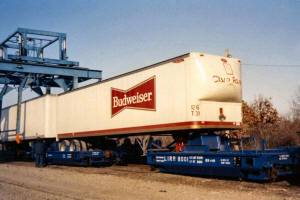
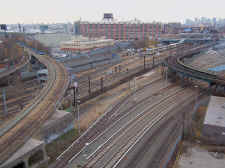 Montauk Cutoff Bogies in storage view SW
11-07 Photo: Kevin Katta Montauk Cutoff Bogies in storage view SW
11-07 Photo: Kevin Katta
The string of bogie
cars on the former Eastbound Montauk Secondary at LI City. They were
marooned behind a bumping block on the east end.
The Bogies still survive to this
day, but are in storage. One long cut is located on a siding in
Hicksville, NY; with another cut on the "Montauk Cutoff"
located in Long Island City. Research: Paul Strubeck
|